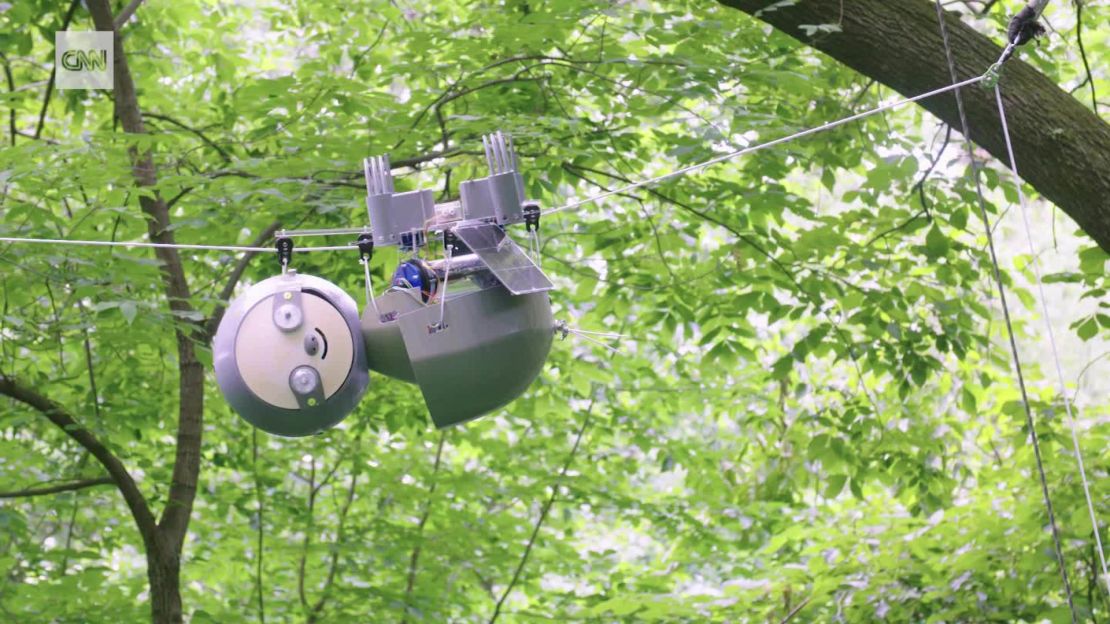From backflipping cheetahs to robo-dogs that mimic man’s best friend, some of today’s most incredible robots have taken their inspiration from the animal kingdom.
Now, robotics engineers at Georgia Tech have turned to an unlikely creature for their latest invention: the lazy, lovable sloth.
Though the SlothBot, as it’s called, may not be as exciting to watch in action as a robotic cheetah or dog, there is purpose in its slowness.
When it comes to monitoring the gradual but critically important changes happening to the global climate, it pays to sit back, relax and stick around for a while.
That’s what the SlothBot is doing as we speak.
Suspended by cables in the tree canopy high above the Atlanta Botanical Garden, the hyper-energy-efficient SlothBot is packed with sensors that are taking readings on everything from temperature, humidity, air quality and carbon dioxide levels.
The idea for the SlothBot first came to Magnus Egerstedt, a robotics professor at Georgia Tech, while on vacation in Costa Rica, where he first encountered the notoriously lethargic animals.
Sloths spend roughly 15 hours each day asleep. And for the few hours that they are awake, they move at a snail’s pace through the tree canopy, often covering less than half the length of a football field in a day.

“I could not understand how these slow, tasty animals that are just sitting there waiting to be eaten by a jaguar could survive,” Egerstedt said. “So I started reading about sloths and I got really excited about embracing slowness in robotics. And when you’re measuring things that are evolving over weeks and months, you don’t have to be fast – it’s OK to be slow, as long as you’re out there and getting the job done.”
With this in mind, Egerstedt and several students in his lab came up with the idea to design a robot that could do just that – reach places that humans and most high-powered robots can’t, like a tree canopy, and stay there to monitor environmental changes over time.
To do this, the SlothBot needed to be extremely energy efficient – sloth-like, if you will – to conserve power and continue sampling the air, without having to be lowered down from the trees and recharged.
Suspended by cables, the SlothBot rarely moves, except when its battery runs low and it needs to crawl along the wires into the sun to recharge via its built-in solar panels.
For now, there is only one SlothBot, but Egerstedt sees huge potential in his creation as a tool to keep an eye on environmental changes, especially in remote locations.
Egerstedt says he is planning to add more sensors to future SlothBot iterations, especially those that can monitor for the presence of pollinators, like bees, butterflies and other insects.
“In particular, we’re interested in tracking and counting pollinators, since they’re a good indication of whether an ecosystem is healthy or not,” he said. “The sky’s the limit for what we can potentially measure.”
Eventually, he envisions a network of SlothBots around the globe, feeding data back to provide scientists with snapshots of the health of different ecosystems.
“Step one to really doing something about the climate threat that we’re facing is really understanding fundamentally what’s going on,” Egerstedt said. “My hope for the future is that there will be many SlothBots deployed under tree canopies in rainforests or in snowy landscapes, doing things like measuring environmental factors.”






















